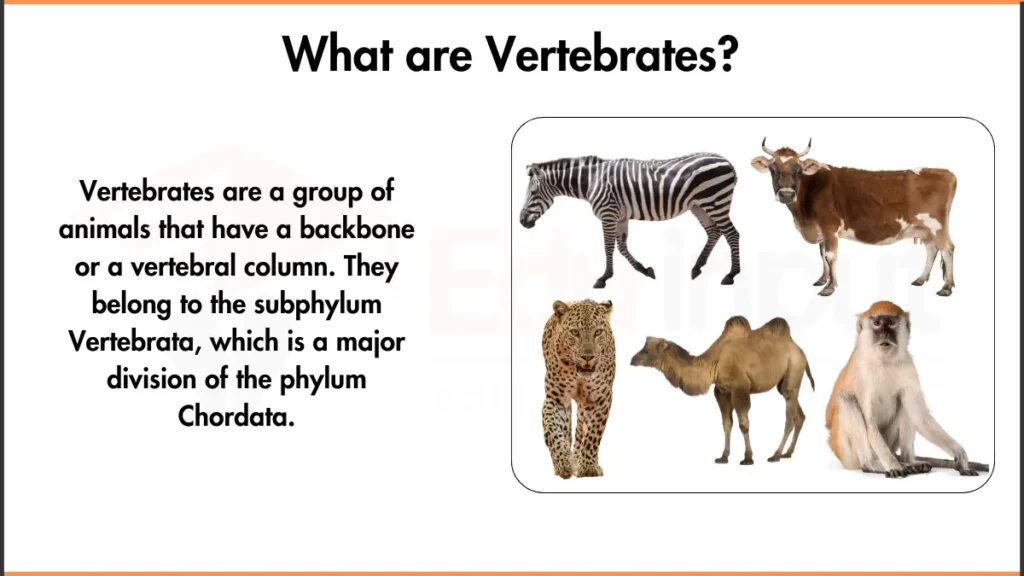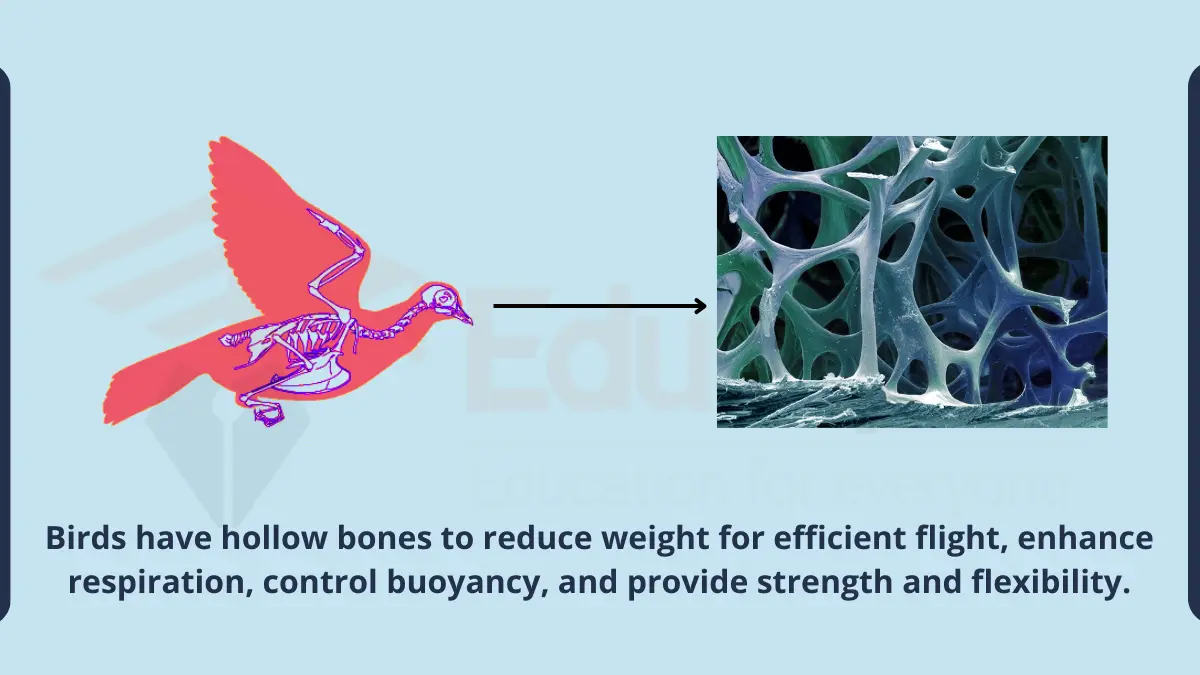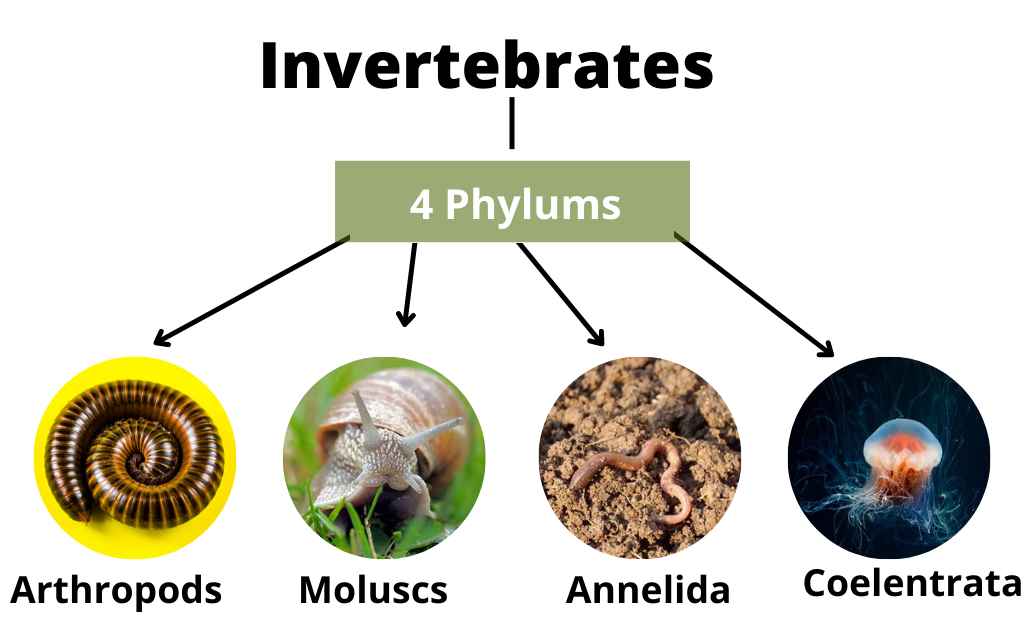Vertebrates – Definition, Evolution, Characteristics, Classification, Systems, and Examples
Vertebrates are the animals that have a backbone or spinal cord.
What is Vertebrate?
Vertebrates are a group of animals that have a backbone or a vertebral column. They belong to the subphylum Vertebrata, which is a major division of the phylum Chordata.

Vertebrates are characterized by the presence of a well-developed internal skeleton made up of individual vertebrae, which provide structural support and protect the delicate spinal cord.
Read How vertebrate are Different From invertebrates
This group includes a wide range of animals such as fish, amphibians, reptiles, birds, and mammals. Vertebrates exhibit diverse body forms, habitats, and lifestyles, and they play crucial roles in various ecosystems.
Read about Vertebrate Ear
Evolution of Vertebrates
The evolution of vertebrates is a remarkable journey that spans millions of years. The earliest vertebrates, which emerged about 500 to 600 million years ago during the Cambrian explosion, were jawless fish.
While they lacked a vertebral column, they possessed a cranium to protect the brain. After the emergence of jawless fish, fish with jaws and a complete vertebral column evolved. These fish, similar to modern sharks, appeared around 450 million years ago.
Read about Skin of Fishes
Around 400 million years ago, the first bony fish with a skeleton made of bone, rather than cartilage, appeared. This allowed for larger body sizes and led to the evolution of modern ray-finned and lobe-finned fish.
Evolution of Fish
After the emergence of jawless fish, fish with jaws and a complete vertebral column evolved. Not too long after the appearance of jawless fish, fish similar to lampreys evolved a partial vertebral column. About 450 million years ago, fish with a complete vertebral column and jaws evolved, possibly resembling modern sharks.
Up to this point, all early vertebrates had an endoskeleton made of cartilage rather than bone. About 400 million years ago, the first bony fish appeared. A bony skeleton could support a larger body. Early bony fish evolved into modern ray-finned and lobe-finned fish.
Evolution of Other Vertebrate Classes
Amphibians, reptiles, mammals, and birds evolved after fish.
The first amphibians evolved from a lobe-finned fish ancestor about 365 million years ago. They were the first vertebrates to live on land, but they had to return to water to reproduce. This meant they had to live near bodies of water.
The first reptiles evolved from an amphibian ancestor at least 300 million years ago. They laid amniotic eggs and had internal fertilization. They were the first vertebrates that no longer had to return to water to reproduce. They could live just about anywhere.
Mammals and birds both evolved from reptile-like ancestors. The first mammals appeared about 200 million years ago and the earliest birds about 150 million years ago.
From Fish to Amphibians
The first jawed vertebrates may have appeared in the late Ordovician (~445 mya) and became common in the Devonian period, often known as the “Age of Fishes”. The two groups of bony fishes, the actinopterygii and sarcopterygii, evolved and became common.
The Devonian also saw the demise of virtually all jawless fishes save for lampreys and hagfish, as well as the Placodermi, a group of armored fish that dominated the entirety of that period since the late Silurian as well as the eurypterids, dominant animals of the preceding Silurian, and the anomalocarids.
Evolution of Endothermy
Endothermy is the ability to regulate body temperature internally. Firstly it was evolved in mammals and birds. This adaptation allows them to have constant body temperature, higher metabolic rates, and adaptability to different environments.
It is important to note that endothermy evolved independently in birds and mammals, originating from separate reptilian ancestors. This evolutionary development occurred on separate paths, demonstrating the convergent evolution of endothermy in vertebrates. However, it is worth mentioning that endothermy requires more energy and higher food intake compared to ectotherms.
Characteristics of Vertebrates
Vertebrates are a diverse group of animals that share several characteristic features at some point in their life cycle. These features include a stiff rod-like structure called the vertebral column or notochord, a central nervous system with a spinal cord running above the vertebral column, an anteriorly placed mouth, an alimentary canal that ends in an anus, and a tail extending beyond the anus. They show following features:
Vertebral Column or Notochord
The Vertebral Column provides support and protection in vertebrates. In most species, the notochord develops into the vertebral column.
Central Nervous System
The Central Nervous System in vertebrates includes the spinal cord, which runs above the vertebral column. It facilitates communication between the brain and the body.
Anterior Placement of the Mouth
Vertebrates typically have a mouth located at the front of the body or just below the head, allowing for efficient ingestion of food.
Alimentary Canal and Anus
The Alimentary Canal is the digestive tract of vertebrates, extending from the mouth to the anus. The anus serves as the exit point for waste elimination.
Tail Extension
In some vertebrates, a tail extends beyond the anus, providing additional mobility and balance.
Head and Sense Organs
The head region of vertebrates contains specialized sense organs. These include the nasal organs for smell, the optic organs for vision, and the otic organs for hearing and balance.
Pharyngeal Slits and Gills
Vertebrates possess pharyngeal slits, openings in the throat region called the pharynx. In aquatic species, these slits are associated with gills for respiration.
Well-Developed Notochord and Spinal Cord
Vertebrates have a well-developed notochord enclosed in connective tissue, with the spinal cord positioned above it. This arrangement provides support and facilitates communication.
Body Cavity (Coelom) and Viscera
The Coelom is a body cavity found in the trunk region of vertebrates, housing various internal organs known as viscera.
Digestive System and Circulatory System
Vertebrates possess a well-developed digestive system, including the esophagus, stomach, and gut. They also have a distinct heart and a closed circulatory system of blood vessels.
Kidneys and Excretory System
Vertebrates have bilateral kidneys, responsible for maintaining fluid balance and excreting waste products. Excretory ducts open through the body wall.
Reproductive Organs
Vertebrates possess reproductive organs, which develop from adjacent tissues to the kidneys. Males often have tubular connections between the reproductive and excretory systems.
Classification of Vertebrates
Vertebrates, or animals with a backbone, are classified into following classes. Each class represents different groups with different features and adaptations.
The main classes of vertebrates are as follows:
1. Agnatha (Jawless Fish)
Agnatha includes primitive fish species that lack jaws, such as lampreys and hagfish. These jawless fish have a cartilaginous skeleton and typically live in freshwater and marine environments. They use a circular mouth lined with teeth to latch onto other fish and feed on their body fluids.
2. Chondrichthyes (Cartilaginous Fish)
Chondrichthyes comprises fish with a cartilaginous skeleton, including sharks, rays, and skates. These fish have well-developed jaws and paired fins, and their skeletons are composed of cartilage rather than bone. They are predominantly marine species and have evolved various adaptations for hunting and survival, such as keen senses and streamlined bodies.
3. Osteichthyes (Bony Fish)
Osteichthyes, or bony fish, are the largest class of vertebrates, with over 30,000 species. They have a bony skeleton, gills for respiration, and paired fins. Bony fish are found in both freshwater and marine environments and display a wide range of adaptations for swimming, feeding, and survival. They are further classified into two subclasses: Actinopterygii (ray-finned fish) and Sarcopterygii (lobe-finned fish).
4. Amphibia (Amphibians)
Amphibia are a class of vertebrates that typically undergo metamorphosis from an aquatic larval stage to a terrestrial adult stage. They have moist skin that aids in gas exchange, lay eggs in water or moist environments, and often have a two-chambered heart. Amphibians include frogs, toads, salamanders, and newts, and they inhabit a wide range of habitats, from rainforests to deserts.
5. Reptilia (Reptiles)
Reptilia comprises cold-blooded animals with scaly skin, lungs for respiration, and amniotic eggs with shells. Reptiles exhibit a variety of adaptations for different environments and lifestyles. They are predominantly terrestrial and include snakes, lizards, turtles, crocodiles, and alligators. Reptiles are ectothermic, relying on external heat sources to regulate their body temperature.
6. Aves (Birds)
Aves, or birds, are warm-blooded animals with feathers, beaks, and lay hard-shelled eggs. Birds have evolved adaptations for flight, such as wings and lightweight skeletons with hollow bones. They possess a four-chambered heart, high metabolic rates, and display diverse characteristics and behaviors. Birds are found in various habitats worldwide and exhibit remarkable diversity in size, shape, and plumage patterns.
7. Mammalia (Mammals)
Mammalia comprises warm-blooded animals that have mammary glands, hair or fur, and give birth to live young. Mammals possess specialized teeth adapted to different diets and exhibit a range of reproductive strategies. They have a four-chambered heart, well-developed lungs, and display diverse adaptations for different lifestyles, including flying (bats), swimming (whales), and terrestrial habitats (humans, dogs, cats, etc.).
Systems in Vertebrate
These systems work together to ensure the proper functioning and survival of vertebrates. The nervous system enables communication and coordination, the circulatory system ensures the transport of essential substances, the respiratory system facilitates gas exchange, the digestive system provides nutrients, and the excretory system eliminates waste. Each system plays a crucial role in maintaining the overall homeostasis of the organism.
Nervous System In Vertebrate
The nervous system in vertebrates is responsible for coordinating and controlling the activities of the body. It consists of the central nervous system (CNS), which includes the brain and spinal cord, and the peripheral nervous system (PNS), which comprises nerves that transmit signals to and from the CNS.
The nervous system allows vertebrates to sense their environment, process information, and respond to stimuli.
Circulatory System In Vertebrate
The circulatory system, also known as the cardiovascular system, is responsible for transporting oxygen, nutrients, hormones, and other substances throughout the body. It includes the heart, which pumps blood, and a network of blood vessels. Vertebrates have a closed circulatory system, where blood flows within vessels.
The circulatory system ensures the delivery of oxygen and nutrients to cells and removes waste products from tissues.
Respiratory System In Vertebrate
The respiratory system facilitates the exchange of gases, primarily oxygen and carbon dioxide, between the organism and its environment. In vertebrates, the respiratory system typically includes organs such as lungs or gills, along with associated structures like the trachea, bronchi, and alveoli.
Vertebrates use specialized respiratory organs to inhale oxygen from the air or water and release carbon dioxide.
Digestive System In Vertebrate
The digestive system is involved in the breakdown and absorption of food and nutrients. It includes structures such as the mouth, esophagus, stomach, small intestine, and large intestine. In vertebrates, accessory organs like the liver, gallbladder, and pancreas also aid in digestion.
Through digestion, vertebrates break down complex food molecules into simpler forms that can be absorbed and utilized by the body.
Excretory System In Vertebrate
The excretory system is responsible for eliminating metabolic waste products from the body. It includes organs such as the kidneys, bladder, and ureters. The kidneys filter the blood, removing waste products and excess water to produce urine. The urine is then transported to the bladder for storage until it is eliminated from the body.
The excretory system helps maintain the body’s fluid balance and removes harmful substances from the bloodstream.
Reproduction in Vertebrates
Reproduction in vertebrates involves sexual reproduction, where males produce sperm and females produce eggs. Fertilization can occur internally or externally. Internal fertilization is common in mammals, reptiles, and some fish, while external fertilization is seen in many fish and amphibians.
Oviparous or Viviparous
Depending on the species, vertebrates may lay eggs or give live birth. Egg-laying species include reptiles and birds, while live-bearing species include most mammals and some reptiles. Parental care is exhibited by many vertebrates, ranging from nest-building to feeding and grooming offspring.
Reproductive strategies in vertebrates
Reproductive strategies vary among vertebrates. Some species engage in courtship rituals and compete for mates, while others form monogamous pairs or engage in polygamous mating systems. Territoriality, displays, and combat may be involved in securing mating opportunities.
Examples of Vertebrates
Here is the vertebrate animals list along with their respective classes:
1. Lamprey – Agnatha (Jawless Fish)
2. Hagfish – Agnatha (Jawless Fish)
3. Shark – Chondrichthyes (Cartilaginous Fish)
4. Ray – Chondrichthyes (Cartilaginous Fish)
5. Salmon – Osteichthyes (Bony Fish)
6. Tuna – Osteichthyes (Bony Fish)
7. Clownfish – Osteichthyes (Bony Fish)
8. Goldfish – Osteichthyes (Bony Fish)
9. Frog – Amphibia (Amphibians)
10. Toad – Amphibia (Amphibians)
11. Salamander – Amphibia (Amphibians)
12. Newt – Amphibia (Amphibians)
13. Snake – Reptilia (Reptiles)
14. Lizard – Reptilia (Reptiles)
15. Turtle – Reptilia (Reptiles)
16. Crocodile – Reptilia (Reptiles)
17. Eagle – Aves (Birds)
18. Sparrow – Aves (Birds)
19. Penguin – Aves (Birds)
20. Ostrich – Aves (Birds)
21. Human – Mammalia (Mammals)
22. Dog – Mammalia (Mammals)
23. Cat – Mammalia (Mammals)
24. Elephant – Mammalia (Mammals)
25. Whale – Mammalia (Mammals)
26. Bat – Mammalia (Mammals)
Phylum Classification Of Vertebrates Flow Chart
Certainly! Here is a flowchart depicting the phylum classification of vertebrates:
Phylum Chordata (Chordates)
|
|— Subphylum Vertebrata (Vertebrates)
|
|— Class Agnatha (Jawless Fish)
|— Class Chondrichthyes (Cartilaginous Fish)
|— Class Osteichthyes (Bony Fish)
|— Class Amphibia (Amphibians)
|— Class Reptilia (Reptiles)
|— Class Aves (Birds)
|— Class Mammalia (Mammals)
Classification Flowchart For Vertebrates
Here is classification flowchart of vertebrates that shows different classes of vertebrates:
Kingdom: Animalia (Animals)
|
Phylum: Chordata (Chordates)
|
Subphylum: Vertebrata (Vertebrates)
|
Class: Agnatha (Jawless Fish)
|
Class: Chondrichthyes (Cartilaginous Fish)
|
Class: Osteichthyes (Bony Fish)
|
Class: Amphibia (Amphibians)
|
Class: Reptilia (Reptiles)
|
Class: Aves (Birds)
|
Class: Mammalia (Mammals)

 written by
written by 



Leave a Reply